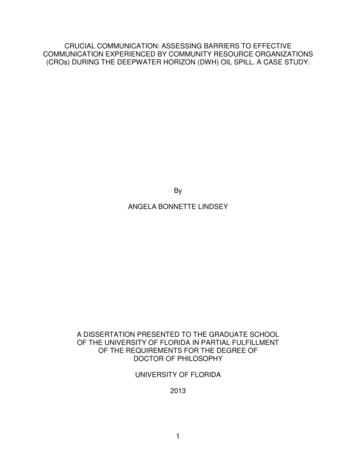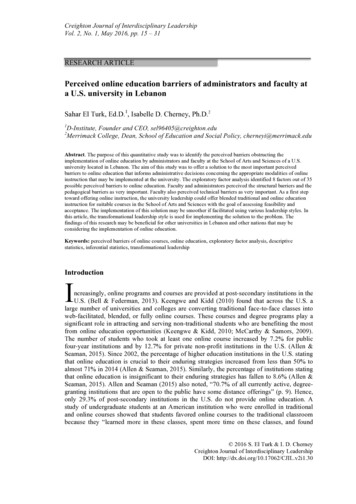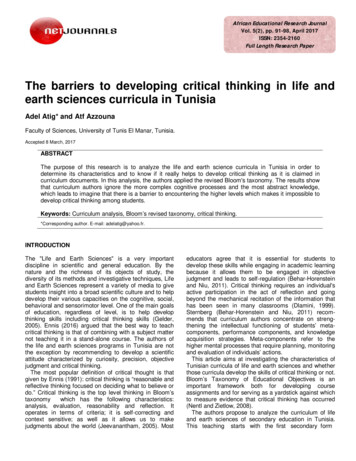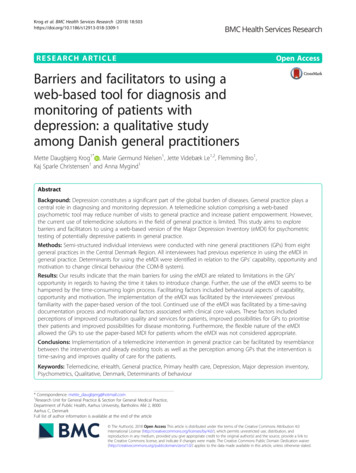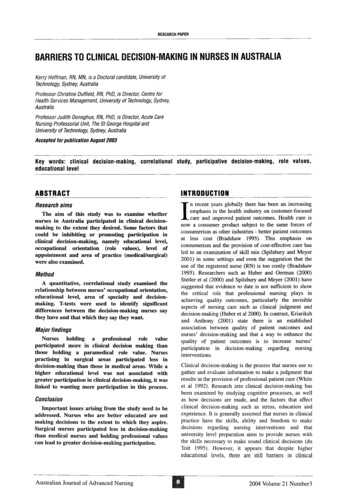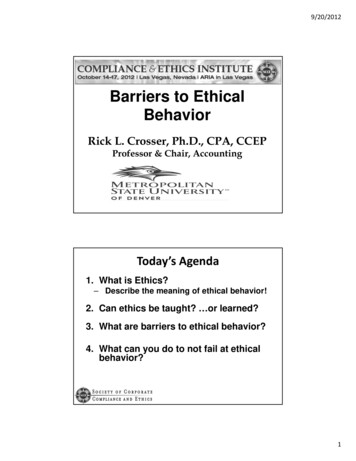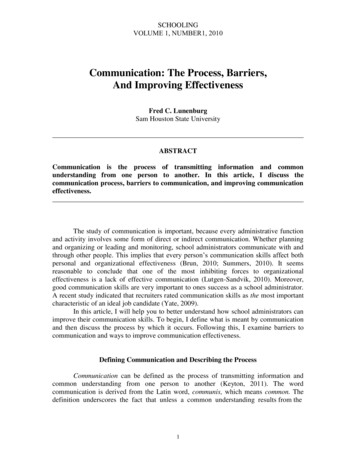
Transcription
SCHOOLINGVOLUME 1, NUMBER1, 2010Communication: The Process, Barriers,And Improving EffectivenessFred C. LunenburgSam Houston State UniversityABSTRACTCommunication is the process of transmitting information and commonunderstanding from one person to another. In this article, I discuss thecommunication process, barriers to communication, and improving communicationeffectiveness.The study of communication is important, because every administrative functionand activity involves some form of direct or indirect communication. Whether planningand organizing or leading and monitoring, school administrators communicate with andthrough other people. This implies that every person’s communication skills affect bothpersonal and organizational effectiveness (Brun, 2010; Summers, 2010). It seemsreasonable to conclude that one of the most inhibiting forces to organizationaleffectiveness is a lack of effective communication (Lutgen-Sandvik, 2010). Moreover,good communication skills are very important to ones success as a school administrator.A recent study indicated that recruiters rated communication skills as the most importantcharacteristic of an ideal job candidate (Yate, 2009).In this article, I will help you to better understand how school administrators canimprove their communication skills. To begin, I define what is meant by communicationand then discuss the process by which it occurs. Following this, I examine barriers tocommunication and ways to improve communication effectiveness.Defining Communication and Describing the ProcessCommunication can be defined as the process of transmitting information andcommon understanding from one person to another (Keyton, 2011). The wordcommunication is derived from the Latin word, communis, which means common. Thedefinition underscores the fact that unless a common understanding results from the1
SCHOOLING2exchange of information, there is no communication. Figure 1 reflects the definition andidentifies the important elements of the communication process (Cheney, eiverEncodeFeedbackFigure 1. The communication process.Two common elements in every communication exchange are the sender and thereceiver. The sender initiates the communication. In a school, the sender is a person whohas a need or desire to convey an idea or concept to others. The receiver is the individualto whom the message is sent. The sender encodes the idea by selecting words, symbols,or gestures with which to compose a message. The message is the outcome of theencoding, which takes the form of verbal, nonverbal, or written language. The message issent through a medium or channel, which is the carrier of the communication. Themedium can be a face-to-face conversation, telephone call, e-mail, or written report. Thereceiver decodes the received message into meaningful information. Noise is anythingthat distorts the message. Different perceptions of the message, language barriers,interruptions, emotions, and attitudes are examples of noise. Finally, feedback occurswhen the receiver responds to the sender's message and returns the message to the sender.Feedback allows the sender to determine whether the message has been received andunderstood.The elements in the communication process determine the quality ofcommunication. A problem in any one of these elements can reduce communicationeffectiveness (Keyton, 2011). For example, information must be encoded into a messagethat can be understood as the sender intended. Selection of the particular medium fortransmitting the message can be critical, because there are many choices.For written media, a school administrator or other organization member maychoose from memos, letters, reports, bulletin boards, handbooks, newsletters, and thelike. For verbal media, choices include face-to-face conversations, telephone, computer,public address systems, closed-circuit television, tape-recorded messages, sound/slideshows, e-mail, and so on. Nonverbal gestures, facial expressions, body position, and evenclothing can transmit messages. People decode information selectively. Individuals aremore likely to perceive information favorably when it conforms to their own beliefs,
FRED C. LUNENBURG3values, and needs (Keyton, 2010). When feedback does not occur, the communicationprocess is referred to as one-way communication. Two-way communication occurs withfeedback and is more desirable.The key for being successful in the contemporary school is the ability of theschool administrator to work with other school stakeholders (faculty, support staff,community members, parents, central office); and develop a shared sense of what theschool/school district is attempting to accomplish – where it wants to go, a shared senseof commitments that people have to make in order to advance the school/school districttoward a shared vision and clarity of goals. As school administrators are able to build ashared mission, vision, values, and goals, the school/school district will become moreeffective. Building a relationship between school administrators and other schoolstakeholders requires effective communication.For example, research indicates that principals spend 70 to 80% of their time ininterpersonal communication with various stakeholders (Green, 2010; Lunenburg & Irby,2006; Matthews & Crow, 2010; Sergiovanni, 2009; Tareilo, 2011; Ubben, Hughes, &Norris, 2011). Effective principals know how to communicate, and they understand theimportance of ongoing communication, both formal and informal: faculty and departmentmeetings; individual conversations with parents, teachers, and students; and telephonecalls and e-mail messages with various stakeholder groups.The one constant in the life of a principal is a lot of interruptions – they happendaily, with a number of one- and three-minute conversations in the course of the day.This type of communication in the work of the principal has to be done one on one - onephone call to one person at a time, one parent at a time, one teacher at a time, one studentat a time; and a principal needs to make time for these conversations. For example, aprincipal may be talking with a parent with a very serious problem. She may be talkingwith a community member. She may be talking with the police about something thatwent on during the school day. The principal must be able to turn herself on and off inmany different roles in any given day.Barriers to Effective CommunicationA school administrator has no greater responsibility than to develop effectivecommunication (Pauley, 2010). Why then does communication break down? On thesurface, the answer is relatively simple. I have identified the elements of communicationas the sender, the encoding, the message, the medium, the decoding, the receiver, and thefeedback. If noise exists in these elements in any way, complete clarity of meaning andunderstanding does not occur. The author, George Bernard Shaw wrote, ‖The greatestproblem with communication is the illusion that it has been accomplished‖ (Shaw, 2011).Four types of barriers (called ―noise,‖ see Figure 1) are process barriers, physical barriers,semantic barriers, and psychosocial barriers (Eisenberg, 2010).
SCHOOLING4Process BarriersEvery step in the communication process is necessary for effective and goodcommunication. Blocked steps become barriers. Consider the following situations: Sender barrier. A new administrator with an innovative idea fails to speak up at ameeting, chaired by the superintendent, for fear of criticism.Encoding barrier. A Spanish-speaking staff member cannot get an Englishspeaking administrator to understand a grievance about working conditions.Medium barrier. A very upset staff member sends an emotionally charged letterto the leader instead of transmitting her feelings face-to-face.Decoding barrier. An older principal is not sure what a young department headmeans when he refers to a teacher as "spaced out."Receiver barrier. A school administrator who is preoccupied with the preparationof the annual budget asks a staff member to repeat a statement, because she wasnot listening attentively to the conversation.Feedback barrier. During a meeting, the failure of school administrators to askany questions causes the superintendent to wonder if any real understanding hastaken place.Because communication is a complex, give-and-take process, breakdowns anywhere inthe cycle can block the transfer of understanding.Physical BarriersAny number of physical distractions can interfere with the effectiveness ofcommunication, including a telephone call, drop-in visitors, distances between people,walls, and static on the radio. People often take physical barriers for granted, butsometimes they can be removed. For example, an inconveniently positioned wall can beremoved. Interruptions such as telephone calls and drop-in visitors can be removed byissuing instructions to a secretary. An appropriate choice of media can overcome distancebarriers between people.Semantic BarriersThe words we choose, how we use them, and the meaning we attach to themcause many communication barriers. The problem is semantic, or the meaning of thewords we use. The same word may mean different things to different people. Words andphrases such as efficiency, increased productivity, management prerogatives, and justcause may mean one thing to a school administrator, and something entirely different to astaff member.Technology also plays a part in semantic barriers to communication. Today'scomplex school systems are highly specialized. Schools have staff and technical expertsdeveloping and using specialized terminology—jargon that only other similar staff and
FRED C. LUNENBURG5technical experts can understand. And if people don't understand the words, they cannotunderstand the message.Psychosocial BarriersThree important concepts are associated with psychological and social barriers:fields of experience, filtering, and psychological distance (Antos, 2011)). Fields ofexperience include people's backgrounds, perceptions, values, biases, needs, andexpectations. Senders can encode and receivers decode messages only in the context oftheir fields of experience. When the sender's field of experience overlaps very little withthe receiver's, communication becomes difficult. Filtering means that more often than notwe see and hear what we are emotionally tuned in to see and hear. Filtering is caused byour own needs and interests, which guide our listening. Psychosocial barriers ofteninvolve a psychological distance between people that is similar to actual physicaldistance. For example, the school administrator talks down to a staff member, whoresents this attitude, and this resentment separates them, thereby blocking opportunity foreffective communication.Successful communication by school administrators is the essence of a productiveschool organization. However, as discussed previously, communications do break down.Several communication theorists (Abrell, 2004; Auer, 2011; Larson, 2011; Shettleworth,2010; Weiss, 2011) have focused on the major areas where failures in communicationmost frequently occur. The following are the major areas where communicationbreakdowns most frequently occur in schools: Sincerity. Nearly all communication theorists assert that sincerity is thefoundation on which all true communication rests. Without sincerity—honesty,straightforwardness, and authenticity—all attempts at communication are destined to fail. Empathy. Research shows that lack of empathy is one of the major obstacles toeffective communication. Empathy is the ability to put one's self into another's shoes. Theempathetic person is able to see the world through the eyes of the other person. Self-perception. How we see ourselves affects our ability to communicateeffectively. A healthy but realistic self-perception is a necessary ingredient incommunicating with others. Role perception. Unless people know what their role is, the importance of theirrole, and what is expected of them, they will not know what to communicate, when tocommunicate, or to whom to communicate. Efforts to distort the message. Pitfalls in communication often occur in ourefforts—both consciously and unconsciously—to distort messages. Images. Another obstacle to successful communication is the sender's image ofthe receiver and vice versa. For example, on the one hand, school administrators aresometimes viewed as not too well informed about teaching, seen as out of touch with theclassroom, and looked on as paper shufflers. On the other hand, some schooladministrators view teachers as lazy, inconsiderate of administrative problems, andunrealistic about the strengths and weaknesses of their students. Such views lead to a
SCHOOLING6"we-they" attitude. Vehicle for message. The vehicle by which we choose to send messages isimportant in successful communication. In most cases, the vehicle to be used is definedby the situation. Ability to communicate. Some of the ways we communicate raise barriers byinhibiting discussion or causing others to feel inferior, angry, hostile, dependent,compliant, or subservient. Listening ability. Frequently, people fail to appreciate the importance of listening,do not care enough to become actively involved with what others are saying, and are notsufficiently motivated to develop the skills necessary to acquire the art of listening. Culture. Our cultural heritage, biases, and prejudices often serve as barriers tocommunication. The fact that we are African-American or white, young or old, male orfemale have all proved to be obstacles in communicating effectively. Tradition. Past practice in a school helps determine how, when, and what we sendand receive. For example, a school administrator who has an authoritative style may findthat his staff will not share information readily. If a new administrator with acollaborative style replaces the authoritarian one, the new administrator may
Four types of barriers (called ―noise,‖ see Figure 1) are process barriers, physical barriers, semantic barriers, and psychosocial barriers (Eisenberg, 2010). SCHOOLING 4_ Process Barriers Every step in the communication process is necessary for effective and good communication. Blocked steps become barriers. Consider the following situations: Sender barrier. A new administrator .

